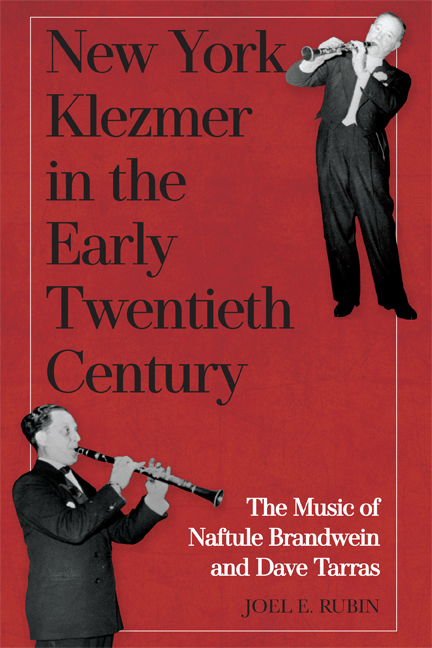Book contents
- Frontmatter
- Contents
- Acknowledgments
- List of Abbreviations
- Note on Orthography and Transliteration
- About the Companion Website
- Introduction: “If You Called Me A Klezmer Thirty-Five Years Ago …”
- 1 A Wedding in Town Was Like a Holiday: A Short History of Klezmorim in Europe
- 2 Klezmer in New York: Changing Meanings, Changing Contexts
- 3 A Kind of “Ethnomusicological Archive”: Commercial 78-rpm Recordings of Klezmer Music
- 4 A Single Field Irrespective of Origin: Polymusicality and Language, Aesthetics, Classification, and Transcription
- 5 “What Mattered Was What’s Happening with the Tune”: Modality and Compositional Processes
- 6 “The Little Things That They Do”: Ornaments and Performance Practice Techniques
- 7 “The Newest Bulgar Out That Everyone Played”: New York Klezmer after 1929
- Glossary
- Notes
- Bibliography
- Index
3 - A Kind of “Ethnomusicological Archive”: Commercial 78-rpm Recordings of Klezmer Music
Published online by Cambridge University Press: 11 September 2020
- Frontmatter
- Contents
- Acknowledgments
- List of Abbreviations
- Note on Orthography and Transliteration
- About the Companion Website
- Introduction: “If You Called Me A Klezmer Thirty-Five Years Ago …”
- 1 A Wedding in Town Was Like a Holiday: A Short History of Klezmorim in Europe
- 2 Klezmer in New York: Changing Meanings, Changing Contexts
- 3 A Kind of “Ethnomusicological Archive”: Commercial 78-rpm Recordings of Klezmer Music
- 4 A Single Field Irrespective of Origin: Polymusicality and Language, Aesthetics, Classification, and Transcription
- 5 “What Mattered Was What’s Happening with the Tune”: Modality and Compositional Processes
- 6 “The Little Things That They Do”: Ornaments and Performance Practice Techniques
- 7 “The Newest Bulgar Out That Everyone Played”: New York Klezmer after 1929
- Glossary
- Notes
- Bibliography
- Index
Summary
“Chief among the Alien Throngs”: The Emergence of a Recording Industry for Jewish and Klezmer Music
The commercial 78-rpm klezmer recordings that Brandwein, Tarras, Beckerman, and others made were part of a general pattern of ethnic-music recording in the early twentieth century. In 1900, 13.5 percent of the total US population was foreign born, and the percentages were even higher in large urban areas. Soon after the transformation of the phonograph “from a curious toy into a serious musical mass medium” during the first decade of the twentieth century, commercial record companies began to recognize the business value of catering to the members of various nationalities. Large quantities of ethnic recordings began to be made by both European and American labels.
Record players were the major medium of home entertainment from approximately 1901 until the ascendancy of radio beginning in the mid- 1920s. In the United States, purchases by the foreign born had become a big business by World War I. Companies came to understand that immigrants in particular held on persistently to their musical traditions, especially those associated with calendar and life-cycle rituals, and that they stood to profit from recording this beloved music. Records “supplied a kind of solace or mediating mechanism for many years, even beyond the 1920s, helping the immigrants to become comfortable in the new land.” Record companies used this solace as leverage to open up ethnic communities to the entire range of recorded music: the hope was that once they had purchased a record player, immigrants would also buy recordings of classical and mainstream entertainment music.
European-born immigrants were seen as more musically sophisticated than Americans and therefore were a vital market to be captured. As I have shown, the musical tastes of eastern European Jews in particular had already begun to shift in the nineteenth century not only toward a Western classical but also toward an urban popular aesthetic. This trend was not lost on the commercial record companies, and Jewish immigrant buyers were singled out for marketing:
Chief among the alien throngs which the tide of immigration brings annually to our shores is the European Hebrew… . It is a well-known fact that he is one of the chief patrons and devotees of the musical art.
- Type
- Chapter
- Information
- New York Klezmer in the Early Twentieth CenturyThe Music of Naftule Brandwein and Dave Tarras, pp. 87 - 101Publisher: Boydell & BrewerPrint publication year: 2020



